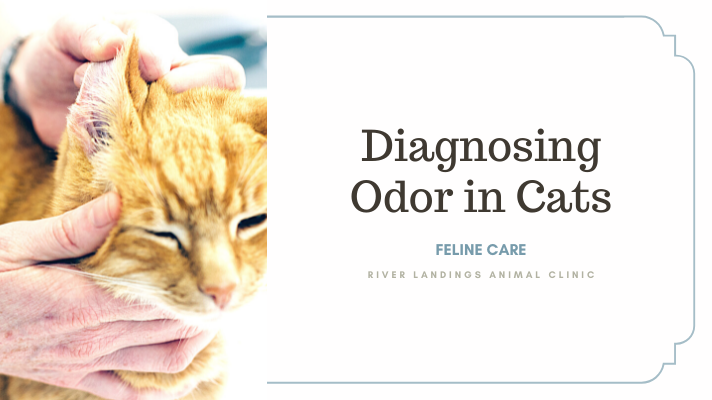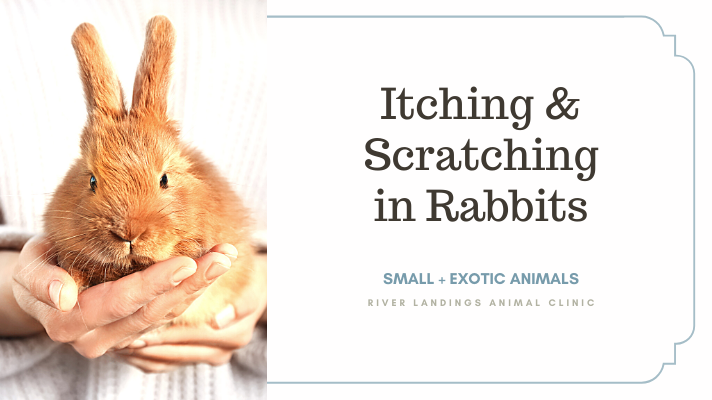Skin odor is a common manifestation of a skin infection. The most common skin infections in cats are bacterial (superficial pyoderma) and yeast (Malassezia dermatitis) infections. Skin discharge and/or odor can indicate that your cat may be suffering from a skin infection.
What are bacterial and yeast infections?
Bacterial infections are usually caused by bacteria that are part of the normal flora of the skin (e.g. Staphylococcus intermedius). For this reason, the infection is not contagious to other animals. In cats that have abnormal skin (e.g. allergies) the bacteria increases in number and causes red bumps (papules) and rancid odor. Some cats with bacterial skin infections also develop excessive shedding, patchy hair loss, and scaling. If the infection is left untreated, it may reach deeper parts of the skin. In these cases, nodules that have a purulent (pus) discharge develop. In most cases skin infections are secondary, so it is very important to pursue an underlying cause. Failure to do so will result in reoccurring infections.
Animals often develop a yeast infection (Malassezia dermatitis), which manifests itself as greasy, red, itchy skin with a rancid odor. Areas most commonly affected include the ventral neck, groin, armpits (axillae), and perineal areas. This infection is also secondary to an underlying disease, most commonly allergies. In some cats this may be a consequence of chronic antibiotic and steroid therapy but, as a general rule, cats do not develop yeast infections after antibiotic therapy as commonly as people do.
Diagnosis of Skin Discharge or Odor in Cats
History is very important for the proper diagnosis of skin diseases. Your veterinarian will ask questions regarding the age of onset, progression of the disease, and response to previous treatments.
Skin cytology provides useful information on the type and severity of infection. Your veterinarian may take samples of skin (e.g. swabs or tape impressions).
In some cases, a biopsy may be necessary to establish a final diagnosis. Some samples may be used for cultures of various types while others may be sent to a pathologist to obtain more information about the cells that are present in the skin.
Treatment for Bacterial Dermatitis
Treatment for bacterial skin disorders is antibiotics. Some of the more commonly used antibiotics include ampicillin, cephalexin, enrofloxacin, clindamycin, clavulinc acid and sulf based drugs.
The minimum length of therapy for superficial pyoderma is 3 to 4 weeks. The minimum length of therapy for deep pyoderma is 8 weeks. As a rule, therapy should be continued for 2 to 4 weeks beyond the resolution of clinical signs.
Treatment of Malassezia Dermatitis
Systemic therapy is reserved for severe cases. It is important to note that griseofulvin is not effective against yeasts. Ketoconazole, itraconazole and fluconazole are all effective against Malassezia.
Topical therapy as the sole treatment is only effective in mild cases while severe cases usually require systemic therapy. Selenium sulfide (Selsun Blue®) is a keratolytic, anti-seborrheic, degreasing agent that will kill Malassezia (effective in 65 percent of cases).
Ketoconazole shampoo (Nizoral®) is approved in many countries for the treatment of seborrheic dermatitis in people and is usually effective in killing Malassezia.
Chlorexidine at 2 to 4 percent might be effective against yeasts, 0.5 to 1 percent is not effective.
Miconazole (Dermazole ®, Resi-zole® leave on conditioner) is also effective.
Vinegar/water rinse (1/5 to 1/10) is a cheap and effective long-term maintenance treatment to prevent relapses.
At-Home Care for Cats
You will need to shampoo your cat with medicated shampoos. Benzoyl Peroxide is an excellent antibacterial antibiotic (e.g. Oxydex®, Pyoben® shampoo). Other antifungal shampoos contain miconazole or ketoconazole (e.g. Nizoral® shampoo for dandruff is now available OTC).
Contact time is important when using a medicated shampoo. You should allow a 10 to 15 minutes contact time for the product to be effective. Leave-on products are also available on the market for prolonged efficacy.
You may have to administer oral medications (either antibiotics or antifungal medications) to help treat the infection. Compliance is very important. Some cats may require medications for a prolonged time as skin infections usually take a while to clear. Speak with your veterinarian before administering medication to your pet.
If your cat keeps relapsing with infections, it is important to pursue an underlying cause. This will decrease the frequency of relapses and reduce the risk of resistance to medications used for prolonged periods of time.
Hear From Us Again
Don't forget to subscribe to our email newsletter for more recipes, articles, and clinic updates delivered straight to your e-mail inbox.
Related Categories:




